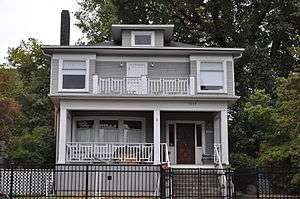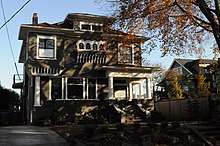Seattle box
Seattle box is a regional style of residential architecture that was popular in Seattle, Washington and elsewhere in the Pacific Northwest in the early 1900s.

Exterior features

The Seattle box is a local variant of the Classic box or foursquare house. Seattle box houses are two or two-and-one-half story single family homes with four main rooms (generally a kitchen, dining room, living room, and entrance hall) on the first floor and four bedrooms on the second floor. One of the defining features of Seattle box houses are extended bay windows on the second floor corners of the facade, often with prominent ornamental brackets. Other distinctive exterior features include low angle hipped roofs and prominent dormer windows in the center of the facade on the second or third (half) story. The entry is usually located on the left or right side of first floor, rather than the center, under a covered porch that is usually inset and supported by stout, blocky columns.
The design of Seattle box houses reflect many of the architectural styles popular in the early 20th century, especially Arts and Crafts and the Prairie style, however some incorporate elements of Tudor, Victorian and Mission architectural styles.[1]
Interior features
Like other foursquare house plans, Seattle box houses typically have eight main rooms on two floors: a living room, entry hall, dining room and kitchen downstairs, and four bedrooms upstairs. The upstairs bedrooms at the front of the house feature sitting benches in front of the bay windows.[2]
History

Seattle box houses were built from the early 20th century until the 1940s. The basic plan for the Seattle box was first described in architect Victor W. Voorhees's plan book Western Home Builder (1907)[3] as simply "Design No. 91". This design proved popular with builders, home-buyers and other architects in Seattle's rapidly growing residential neighborhoods and streetcar suburbs, to the extent that some blocks of Seattle's Capitol Hill neighborhood developed around 1910 were built almost entirely according to this plan.[2]
Houses were also built according to the Seattle box plan, by Voorhees and others, in Pacific Northwest cities such as Vancouver, British Columbia,[4] Bellingham, Washington[5] and Portland, Oregon. Many Seattle box houses are listed as historical landmarks in their local municipalities.
In the early 21st century, elements of the classic Seattle box plan were revived in new home developments in Seattle's Central District.[6]
References
- Chesley, Frank (August 19, 2009). "Housebuilding in Seattle: A History - Historylink.org essay 9116". HistoryLink.org: The Free Encyclopedia of Washington State History. Retrieved November 22, 2014.
- Gault, Lila (1981). The House Next Door: Seattle's Neighborhood Architecture. Seattle, WA USA: Pacific Search Press. pp. 40–44.
- Andersen, Dennis A.; Krafft, Katheryn H. (October 1994). "Plan and Pattern Books: Shaping Early Seattle Architecture". Pacific Northwest Quarterly. 85 (4): 150–158. JSTOR 40491583.
- "Arthur & Charlotte Green Residence". Canada's Historic Places. Parks Canada. Retrieved November 22, 2014.
- "1020 Key Street". Neighborhoods of Bellingham. Bellingham Public Library. Retrieved November 22, 2014.
- Mudede, Charles (July 28, 2005). "Unwelcome Homes: Monster Mansions Prepare to Take Over the Central District". The Stranger. Retrieved November 22, 2014.